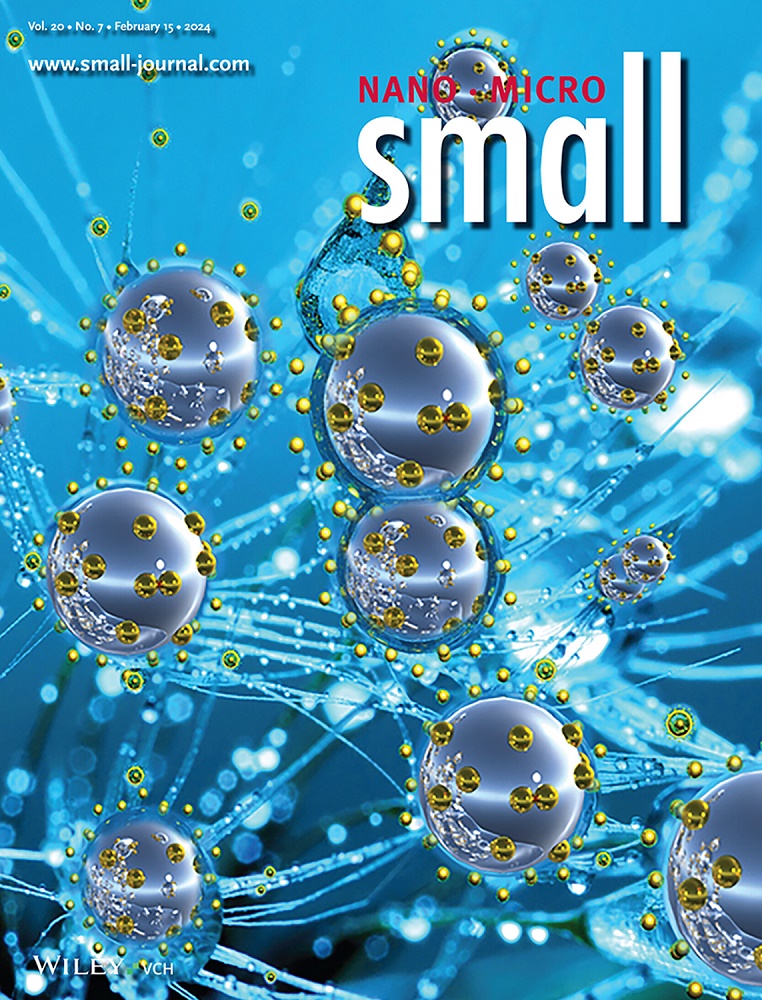Novabeads: Stimuli-Responsive Signal-Amplifying Hydrogel Microparticles for Enzymeless Fluorescence-Based Detection of microRNA Biomarkers.
IF 12.1
2区 材料科学
Q1 CHEMISTRY, MULTIDISCIPLINARY
引用次数: 0
Abstract
Robust and ultrasensitive biosensing platforms for detecting clinically relevant biomarkers from liquid biopsies are vital for precision diagnostics. However, detecting low-abundance biomarkers such as microRNA typically necessitates complex and costly enzyme-based strategies like PCR or isothermal amplification. Here, a materials-driven approach is leveraged to rationally design stimuli-responsive, signal-amplifying, and graphically-encoded hydrogel microparticles, termed Novabeads, for enzyme-free and fluorescence-based biomarker detection. Novabeads incorporate pH-responsive acrylic acid moieties within a polyethylene glycol diacrylate-based network, enabling significant volume reduction (≈5 fold) upon pH modulation. This stimuli-responsive shrinking, coupled with high bioreceptor loading via thiol-ene click chemistry, enables rapid, enzyme-free optical signal amplification. As a proof-of-concept, fluorescently-labeled peptide nucleic acid (PNA) probes are designed for detecting the cancer biomarker miR-16, via a fluorogenic oligonucleotide-templated reaction, generating a Förster resonance energy transfer (FRET)-based signal. Novabeads exhibit >30 fold signal enhancement over equivalent conventional hydrogel microparticles, driven by three synergistic mechanisms: increased probe loading (≈2.6 fold), enhanced target capture (≈2.8 fold), and shrinkage-driven amplification (≈5 fold), ultimately leading to over 7 fold reduction in detection limit (28.8 pM; 2.9 fmol), and an expanded linear dynamic range. This rationally designed materials-driven biosensing strategy enables next-generation robust, versatile and enzyme-free biosensors for liquid biopsy diagnostics.Novabeads:用于无酶荧光检测microRNA生物标志物的刺激响应信号放大水凝胶微颗粒。
从液体活检中检测临床相关生物标志物的强大和超灵敏的生物传感平台对于精确诊断至关重要。然而,检测诸如microRNA之类的低丰度生物标志物通常需要复杂且昂贵的基于酶的策略,如PCR或等温扩增。在这里,利用材料驱动的方法来合理设计刺激响应,信号放大和图形编码的水凝胶微粒,称为Novabeads,用于无酶和基于荧光的生物标志物检测。Novabeads在基于聚乙二醇二丙烯酸酯的网络中加入pH响应丙烯酸部分,在pH调节下可以显着减少体积(≈5倍)。这种刺激响应收缩,加上通过巯基点击化学的高生物受体负载,实现了快速、无酶的光信号放大。作为概念验证,荧光标记肽核酸(PNA)探针被设计用于检测癌症生物标志物miR-16,通过荧光寡核苷酸模板化反应,产生Förster共振能量转移(FRET)为基础的信号。与等效的传统水凝胶微粒相比,Novabeads的信号增强了30倍,这是由三种协同机制驱动的:增加探针负载(≈2.6倍)、增强目标捕获(≈2.8倍)和收缩驱动放大(≈5倍),最终导致检测限降低了7倍以上(28.8 pM;2.9 fmol),线性动态范围扩大。这种合理设计的材料驱动的生物传感策略使下一代强大的、通用的、无酶的生物传感器能够用于液体活检诊断。
本文章由计算机程序翻译,如有差异,请以英文原文为准。
求助全文
约1分钟内获得全文
求助全文
来源期刊

Small
工程技术-材料科学:综合
CiteScore
17.70
自引率
3.80%
发文量
1830
审稿时长
2.1 months
期刊介绍:
Small serves as an exceptional platform for both experimental and theoretical studies in fundamental and applied interdisciplinary research at the nano- and microscale. The journal offers a compelling mix of peer-reviewed Research Articles, Reviews, Perspectives, and Comments.
With a remarkable 2022 Journal Impact Factor of 13.3 (Journal Citation Reports from Clarivate Analytics, 2023), Small remains among the top multidisciplinary journals, covering a wide range of topics at the interface of materials science, chemistry, physics, engineering, medicine, and biology.
Small's readership includes biochemists, biologists, biomedical scientists, chemists, engineers, information technologists, materials scientists, physicists, and theoreticians alike.
 求助内容:
求助内容: 应助结果提醒方式:
应助结果提醒方式:


